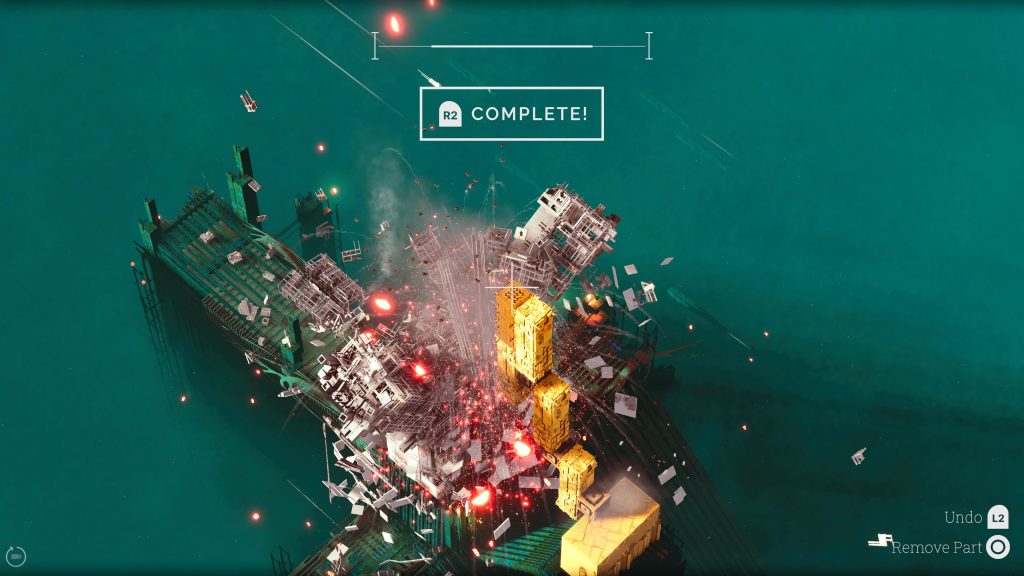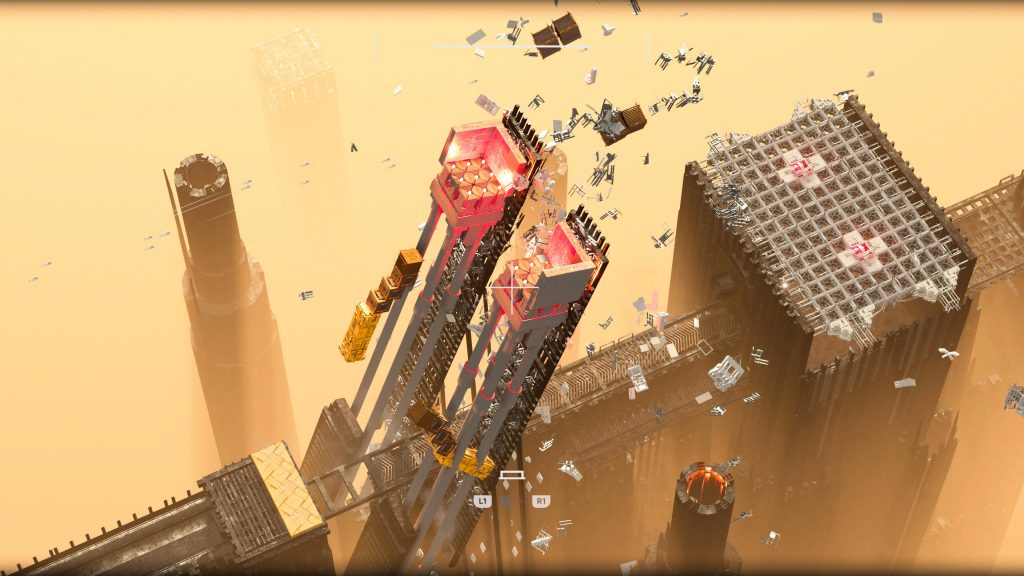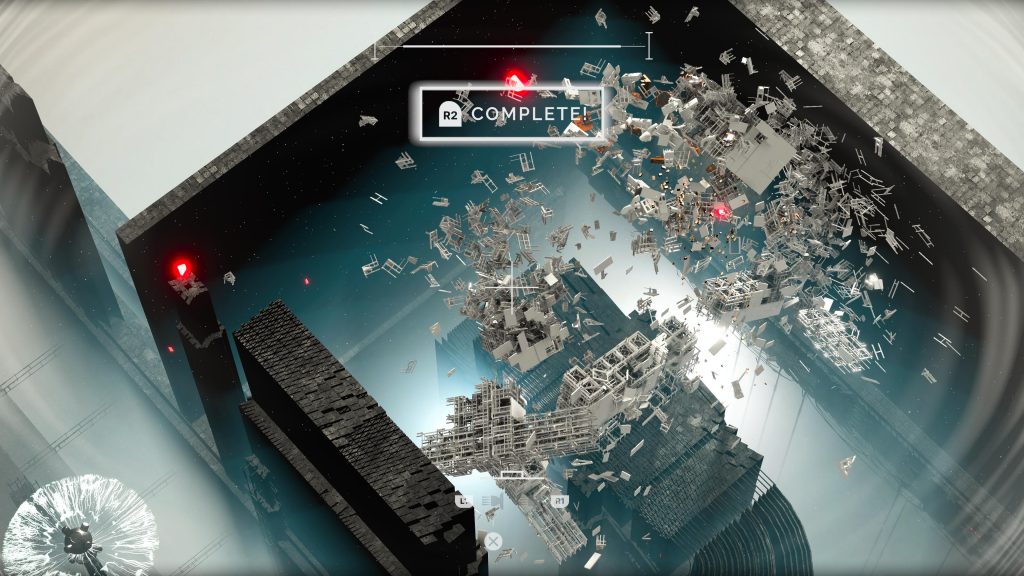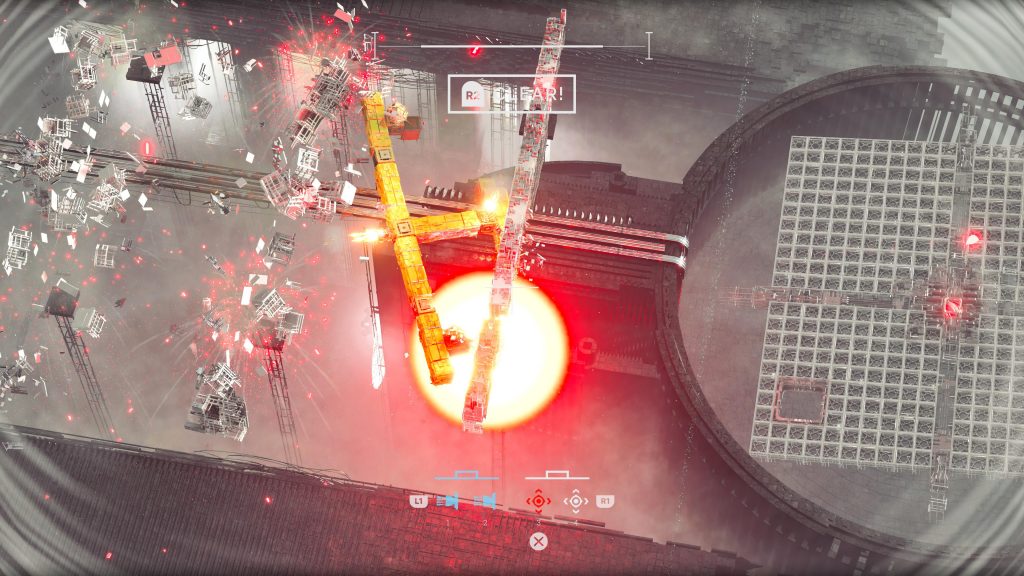Abriss, or to give it’s full title ABRISS – build to destroy, is a physics-based puzzle game from Berlin-based studio Randwerk and it’s really quite something. As it’s annoyingly uncapitalised subtitle suggests, this game is about building and destruction but it’s done in a way that’s wholly original and just technically so impressive.
Okay, so we’re leaping in here but so does the game. Firing it up for the first time, you’ll be thrown straight into the first stage with no pre-amble, story or guidance. Indeed, we were so thrown by it that we had to back out and start looking for a tutorial. Thankfully, one exists (it’s in the level map screen) and it tells you the basics which are surprisingly simple once you get what the game wants you to do.
 Each stage of Abriss‘ main campaign has a white structure with one or more red orbs that act as targets. Now, generally those targets aren’t anywhere near where you’ll be active and so you’ll need to build a structure that can either fall onto the orb, as is the case in the first few stages, or is capable of delivering some sort of destruction to the target. To do this, you’ll be given a limited selection of parts to build with such as heavy cubes, long blocks and connectors.
Each stage of Abriss‘ main campaign has a white structure with one or more red orbs that act as targets. Now, generally those targets aren’t anywhere near where you’ll be active and so you’ll need to build a structure that can either fall onto the orb, as is the case in the first few stages, or is capable of delivering some sort of destruction to the target. To do this, you’ll be given a limited selection of parts to build with such as heavy cubes, long blocks and connectors.
Initially, all you’ll need to do is build a towering structure that is weighted on one side and let gravity do the rest and, as your structure falls and crashes into the target building, everything crumbles and explodes in a way that really impresses. This isn’t your Bridge Constructor type of presentation, this is something altogether more impressive. We can’t even imagine how the physics are being calculated here. In a way it reminds us of the brilliant Hardspace: Shipbreaker. The way that everything is constructed from tiny parts that make a whole but break apart. It’s the sort of operatic destruction that John Woo must fantasise about. It’s no wonder that this is PS5 only as trying to run this on even a PS4 Pro would be like kicking that thing in the nuts.
 However, there are a lot of levels in the campaign and just dropping structures onto buildings wouldn’t keep you interested for long. But that’s all good because Abriss mixes things up nicely by adding new elements along the way. Early on you’ll get Thrusters. Stick one of these onto your structure and activate it and you’ll hopefully send the whole construction flying at your target. One early level requires you to hit seven orbs on a level base that’s a flat rail. So we created a long airplane-like structure and stuck a thruster one there. It was a great idea but it didn’t work but with a little bit of strategic weighing down, we eventually cleared the level and it felt GREAT.
However, there are a lot of levels in the campaign and just dropping structures onto buildings wouldn’t keep you interested for long. But that’s all good because Abriss mixes things up nicely by adding new elements along the way. Early on you’ll get Thrusters. Stick one of these onto your structure and activate it and you’ll hopefully send the whole construction flying at your target. One early level requires you to hit seven orbs on a level base that’s a flat rail. So we created a long airplane-like structure and stuck a thruster one there. It was a great idea but it didn’t work but with a little bit of strategic weighing down, we eventually cleared the level and it felt GREAT.
The game also adds bombs, hinges (that can combine to make chains), pistons, lasers and much more which helps to keep things fresh and gives you more and more opportunities to create beautiful destruction. But, of course, most puzzle games work this way; adding new elements as you go. And that can often make them feel like extending tutorials or, worse, take an enjoyable early concept and then make it needlessly complicated at the end. If you ever played Hitman: Go, you’ll know what we mean. Initially fun but eventually a horrific trial-and-error grind to figure exactly what the game wants from you.
 Well, Randwerk have avoided all that by making it so that you’re not tied to one solution. The physics here are powerful enough that you’ll likely be able to come up with you own solution. That said, some of the laser-based solutions did seem to be a bit more precise but there is an in-game hint system that can get you through any stages you’re not enjoying. So, despite the potential for complexity, Abriss always feels like its levels are fair and achievable.
Well, Randwerk have avoided all that by making it so that you’re not tied to one solution. The physics here are powerful enough that you’ll likely be able to come up with you own solution. That said, some of the laser-based solutions did seem to be a bit more precise but there is an in-game hint system that can get you through any stages you’re not enjoying. So, despite the potential for complexity, Abriss always feels like its levels are fair and achievable.
The gameplay is great really. We’ve not seen anything like this before. Sure, there have been destruction-based puzzlers before (shout out to Bomber Hehhe, the Dreamcast’s best hidden gem) but Abriss executes in a way that is just so impressive. We even found ourselves replaying levels just to see the results unfold over and over. This is all helped by the stark, modern visuals which combine Tetsuya Mizuguchi (Rez, Tetris Effect, Lumines) type aesthetics with high detail to really sell the game’s incredible physics. The kick-drum heavy soundtrack pulses along nicely enough but this one’s all about the eye candy.
 The only downsides come from the game’s transition from PC to console. While the controls work, they are fiddly, often seeming to move away from where you’re trying to work and trying to activate different elements (such as spinners and lasers) at the same time can be awkward. It’s a weird feeling but it was almost like our DualSense had stick drift (which it doesn’t). It figures that controlling your build with a mouse would be a lot easier but we’re not convinced that the joypad controls couldn’t have been better optimised.
The only downsides come from the game’s transition from PC to console. While the controls work, they are fiddly, often seeming to move away from where you’re trying to work and trying to activate different elements (such as spinners and lasers) at the same time can be awkward. It’s a weird feeling but it was almost like our DualSense had stick drift (which it doesn’t). It figures that controlling your build with a mouse would be a lot easier but we’re not convinced that the joypad controls couldn’t have been better optimised.
But that’s a fairly minor niggle (although one we’d love to see patched) for a game that comes with some real originality, great level design and a whole heap of style. And for £15.99, it all seems like a bit of a bargain.
+ Stylish visuals
+ Clever level design

